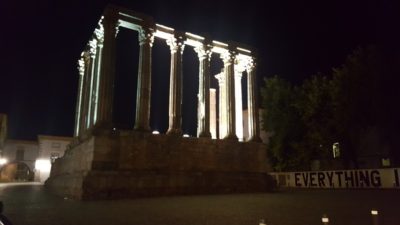
The Roman Temple in Évora
Oct. 14: I write this from our new home, the Convento de Évora, located in the heart of the Alentejo. We awoke in Lisbon and got organized to head east into the Alentejo, the next chapter of our travels. The Alentejo occupies about one third of all of Portugal and it’s pretty much the bottom third of the country, minus Lisbon and the southern coast. We were attracted to it since it is rural and a bit more off the beaten track.
It was about 10:30 am when we finally hit the road. The traffic and detours leaving the city were no fun, but we eventually made it to the bridge over the Tagus. We hadn’t realized how wide the Tagus River is, until we went over the Vasco de Gama Bridge. It is 10.7 miles long and the longest bridge in Europe. It seemed like we’d be over water forever!
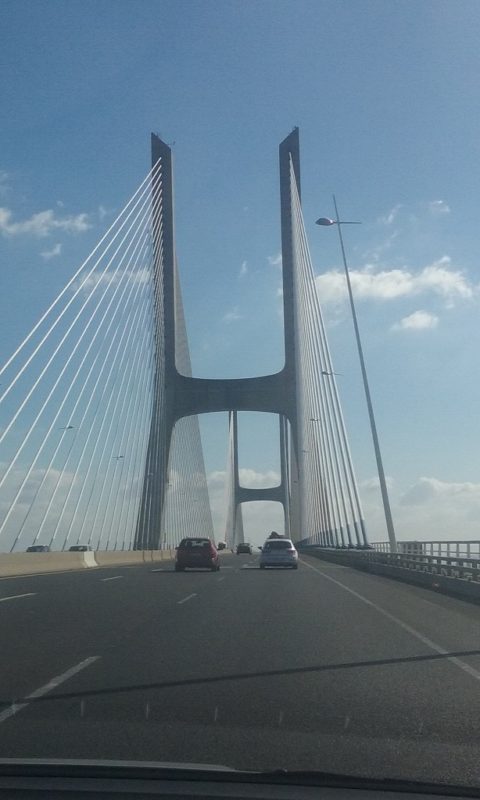
The Vasco de Gama Bridge Connects Lisbon and the Alentejo
As soon as we were east of the Tagus, we could tell we had made a transition. Even driving through the country side we could tell that life was moving more slowly. Évora was our destination for the day, but we decided to do some sightseeing in the outlying areas before we went to Évora. As we drove we were treated to views of gently rolling hills dotted with cork oaks. We wanted to explore one the megalith compounds in these hills.
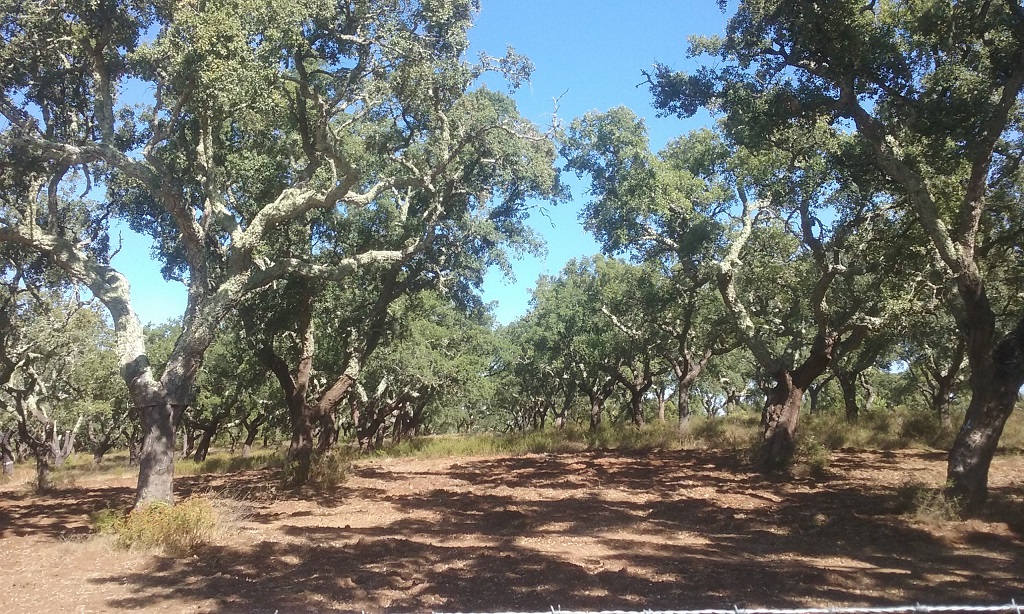
Cork Oaks Dominated the Landscape
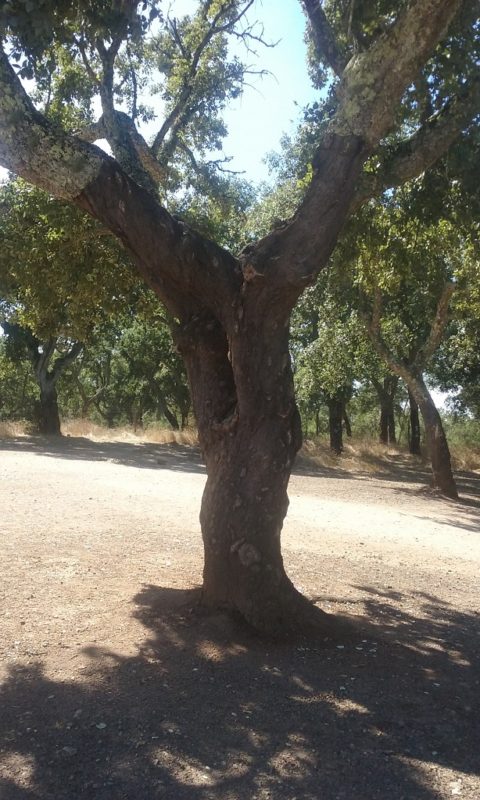
Notice How the Bottom Bark Is Harvested for Cork
There are megalith compounds spread out all over the Iberian Peninsula, and the largest compound of menhirs, Cromeleque Dos Almendres, happens to be fifteen kilometers outside of Évora. The common agreement is that they were put there around 6000 BC. There are 95 of them. Although there are some patterns in their placement, there is really not much rhyme or reason to their layout. Archeologists are still trying to figure out exactly what role they played in people’s lives. We haven’t a clue ourselves, but we very much liked walking around and through the compound, noting the mystery and austere beauty in the menhirs themselves.
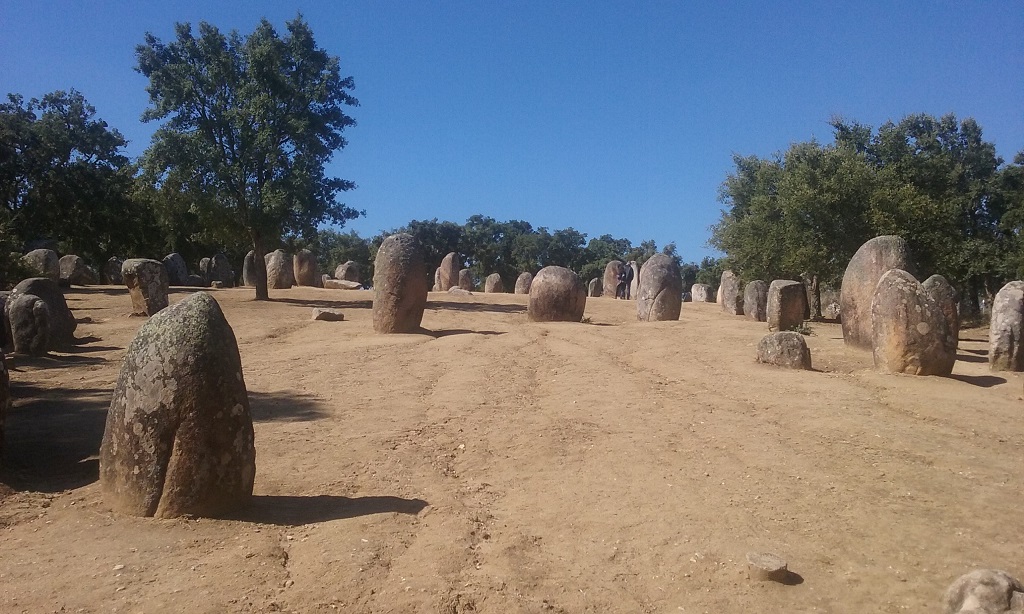
These Megaltihs Are 8,000 Years Old
Two and a half kilometers up the road there was a sign for Menhir do Monte Dos Almendres, a single twelve foot menhir, which is about twice as big as the others. It is believed to be related to the other compound because at summer solstice the two locations line up perfectly.
Something happened before we even walked to the menhirs at Cromeleque Dos Almendres and I want to share it with you, as it was so sweet. We stopped at the trail head where there was a man on a bench playing a violin, but holding it like a cello. There was already a family of five people surrounding him and his wife. We quietly joined them.
When the music stopped, we all clapped and the conversation began. It turns out the musician is Cornelius Hummel, a German cellist. He and his wife were riding their bikes through Europe, Portugal being the fifth country. He did not have his cello because a violin is all he could pack on the bike. The other family were Americans and had ties to Long Island where I grew up. Three of the five Americans were Waldorf teaches. I sent my son to Waldorf schools for his education. So in some ways, we were cut from the same fabric. Time passed without notice as we all stood there exchanging stories and getting to know each other. This was one of those spontaneous moments that make traveling very special.
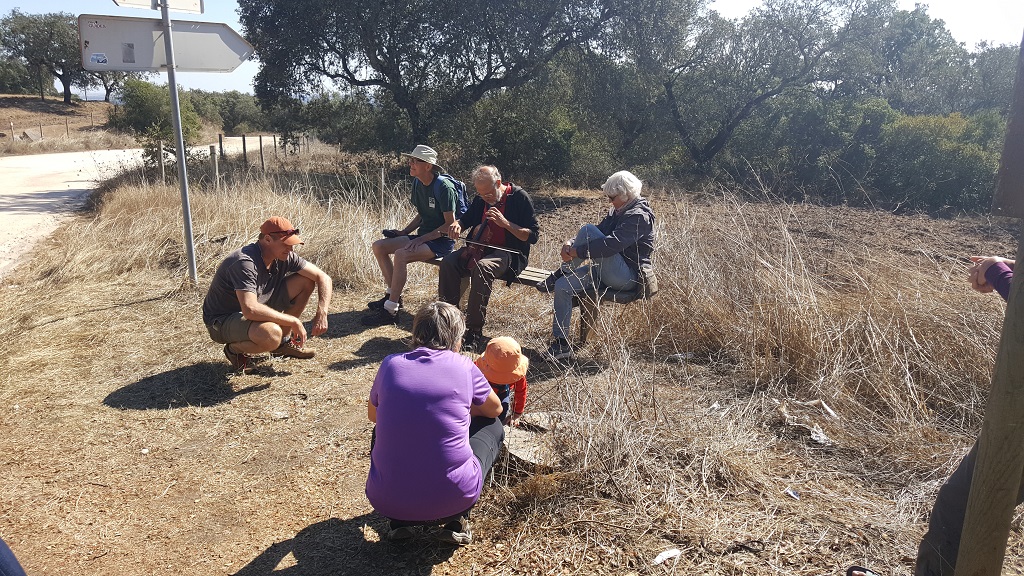
We Stumbled upon a German Cellist and Some Friendly Americans
After viewing the megaliths, we were off to Arraiolos, a small village about 20 kilometers north of Évora. Its claim to fame is the artisanal handicrafts, in particular their rugs and tapestries. They use jute as a structural backboard and then wool of various colors to embroider over the jute cloth. Dan and I were both interested in picking up a piece, should the right piece of art call to us.
Driving north, we could see the village in the distance, because it’s spread around the base of the hill capped by a castle. All the buildings looked the same. They had white walls with bright blue trim. We felt like we had been transported to a Greek village. Our initial attempt at driving on the narrow streets was a bit daunting, so we happily parked and walked around for the afternoon.
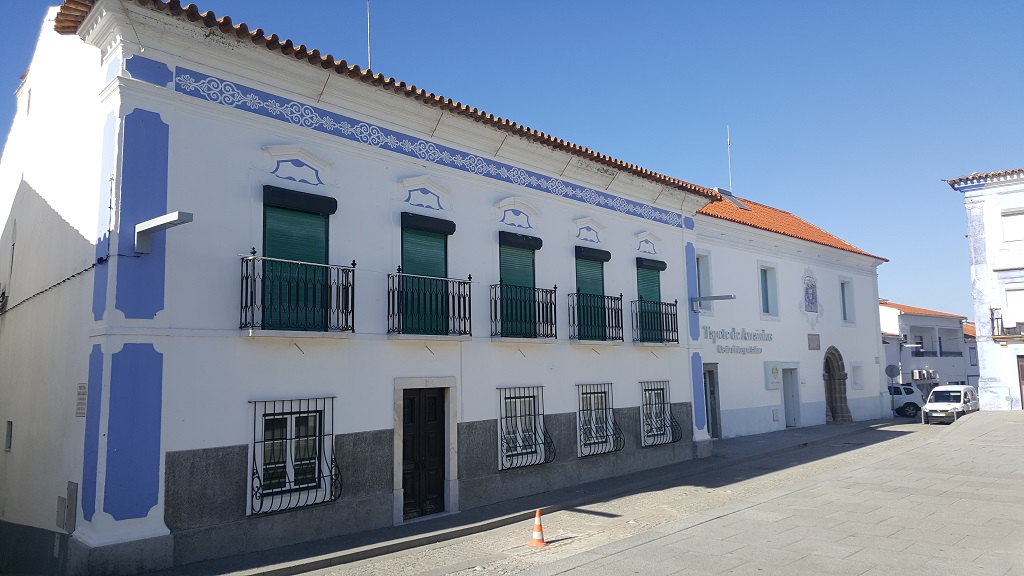
Instead of Tile Facades Like Lisbon the Buildings All Sported the Whitewashed with Blue Trim Exteriors
As expected, English was not spoken nearly as much as in Lisbon, although without a doubt most of the people could speak better English than we could Portuguese. We perused a couple rug shops, but honestly nothing jumped out at us. So we landed at a café table in the main plaza and got a light bite to eat. The food was simple and it very much had a local vibe. We immediately noticed that since we were inland, the menus had changed their focus to pork. This being said, we got the one fish dish that they offered.
On a warm, sunny day, it stands to reason that there would be a lot of people hanging out in the plaza. But you wouldn’t necessarily assume that 95% of them were male, which happened to be the case. I have seen a similar thing in Central America and have wondered if it is a result of an expectation that women should stay home and tend to home matters, or they simply have no interest in sitting around drinking beer. Maybe a bit of each.
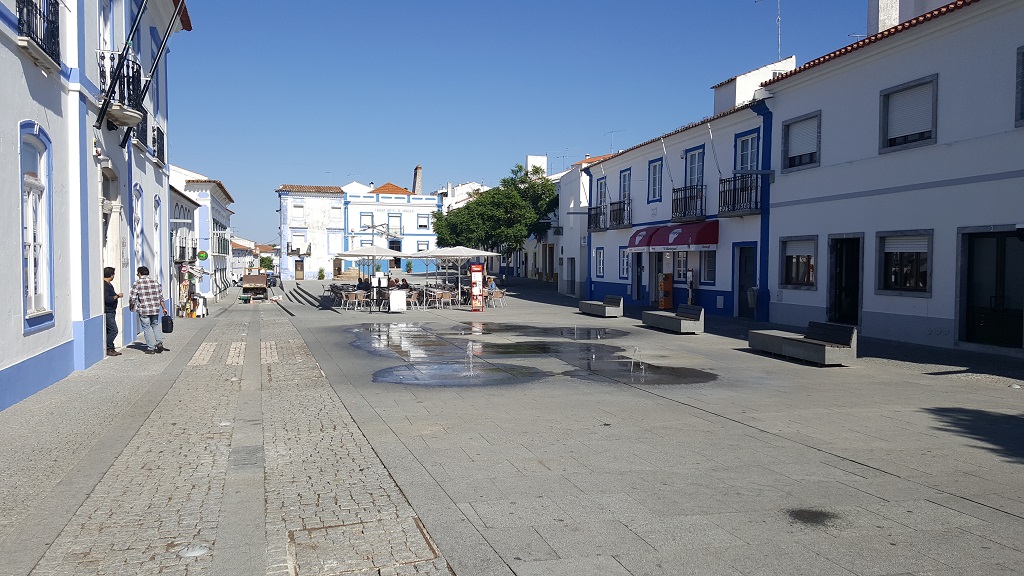
The Plaza in Arriolos
The Interpretive Center by the plaza was the local museum. Its focus was on the long term history of the land where Arraiolos now stands. The interesting backstory was that, as chance would have it, the center was constructed on archeological remains. When the excavation began to build the center, they discovered the dyeing pits that were used in the 1500’s. This is where they dyed the wool for the rugs. One room had a see through floor that revealed some of the dye pits. The discovery of the dye pits led to further archeological digs tracing the history of the site back to the Romans.
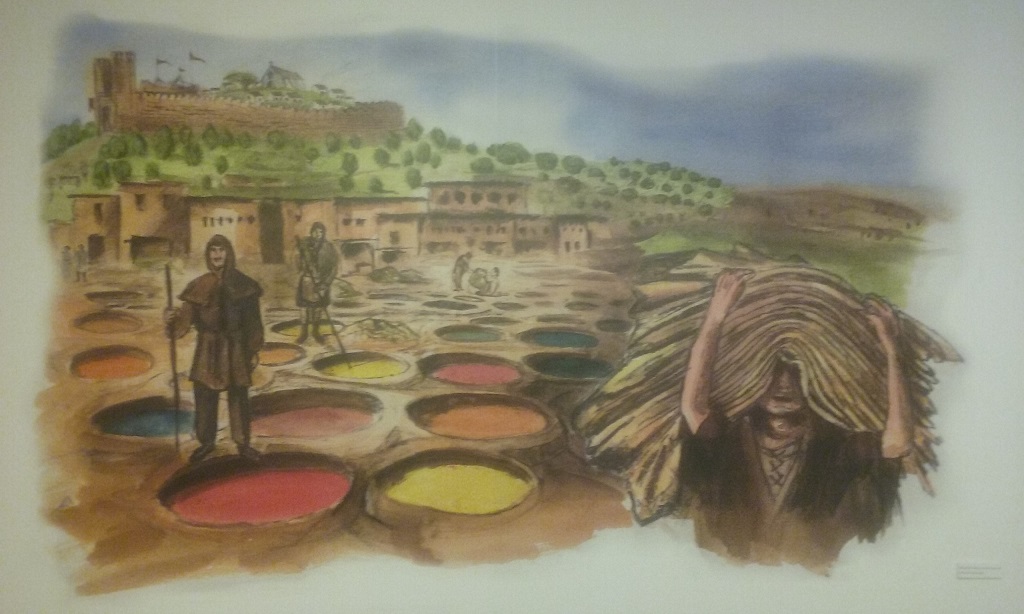
This Depicts the Dye Pits That Existed in Arriolos in the 1500’s
This modest building had a lot of stunning marble features. This is because marble is mined from other nearby villages. We probably won’t have time to visit them, but Estromoz is about 40 kilometers away and it is known as the marble capital of the region.
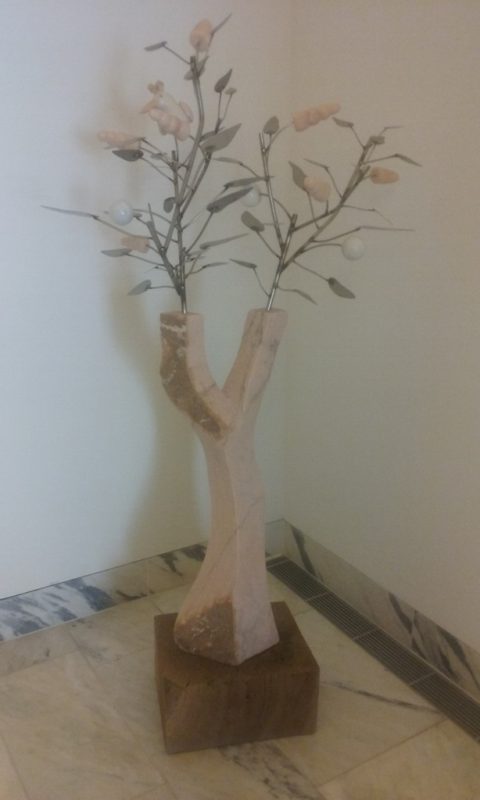
I Was Starting to Notice the Generous Use of Marble in the Region
The next visit was to the castle on top of the hill. It is always open to the public, although the small church that is hidden inside of it is closed. We had fun climbing on the wall that surrounded it. But don’t look straight down, especially if you are afraid of heights. The view in the distance revealed the quintessential Portugal – small white homes with orange roofs. The castle is in ruins but enough towers and walls remained to give us a sense of what used to be there. It was built in 1305 to serve as protection against outside invaders. It took about five years to complete, but about 70 years later, it was invaded and it was never used for defensive purposes again. Talk about a short life!
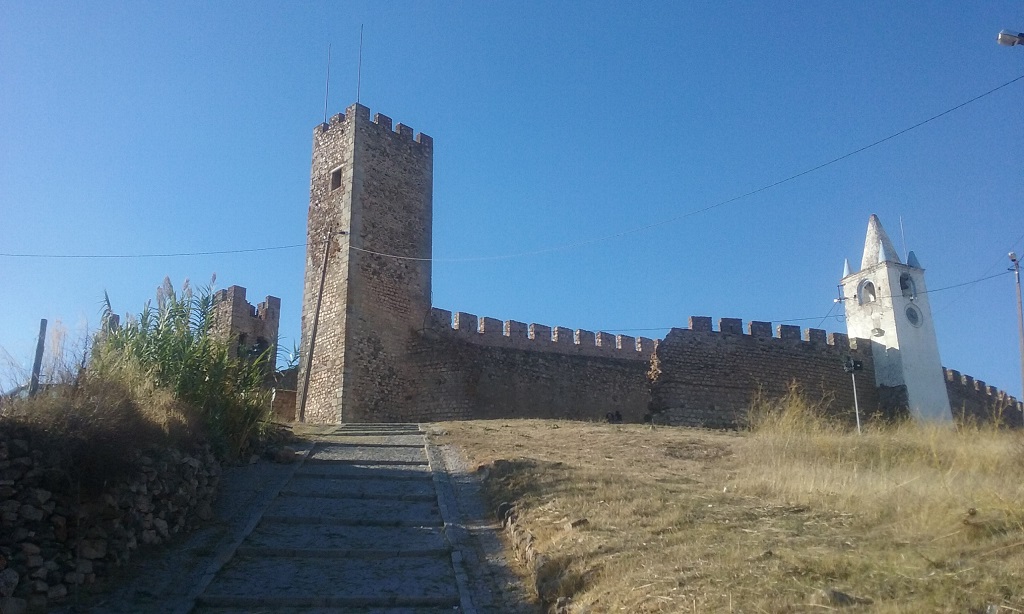
The Castle in Arriolos Was Underutilized during Its Life
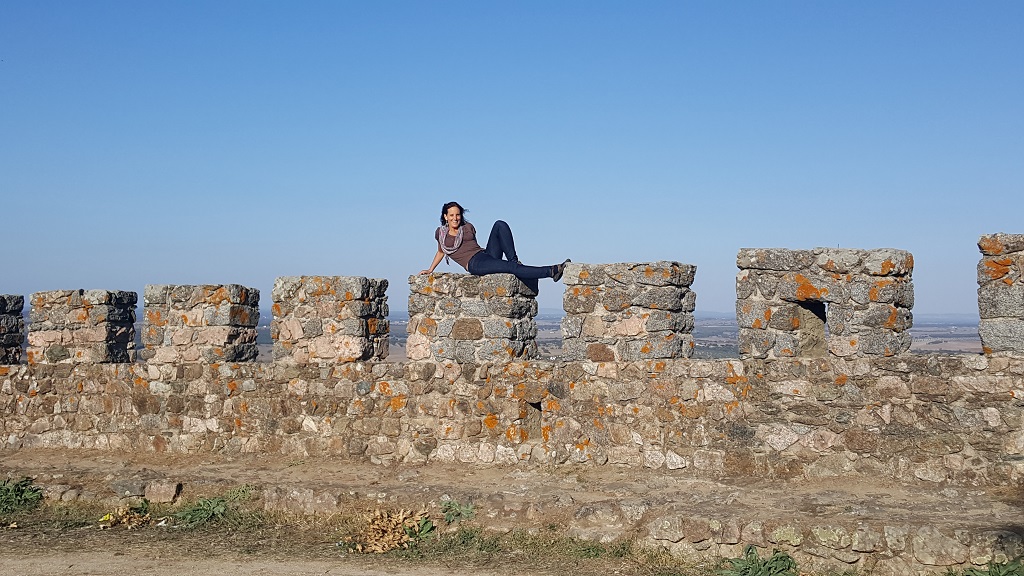
But We Gave It New Purpose
We were thoroughly enjoying our village wanderings, but we did have some decisions to make around rugs. Arraiolos rugs are famous worldwide and we wanted to see what they offered us. We had been in and out of a bunch of stores and nothing grabbed us, except for one shop owner that we connected with. She is the designer and artist and employs 35 local women. There was one section of a large tapestry Dan really liked and she assured him that she could have that design made into a small rug. She had a good sales shtick when she said “in a month, you can have the rug of your dreams!” So back we went.
What I really liked is that we got to see a woman sitting and working while we were there. It happened she was repairing a 45 year old rug, instead of making a new one. But regardless, it was totally engaging for us to see her work so methodically and purposefully to create something both beautiful and useful.
The shop keeper, Hortense, measured and clarified the order. She was very attentive and wanted to make sure Dan got exactly what he wanted. We chatted with her a bit about her craft. She was born and raised in Arraiolos but travels to the US to see clients, as well as creates special orders for people worldwide.
All the rugs in her shop had a certain style to them, as this was the traditional look of the region. Yet when she showed us some of her portfolio (on her smart phone), we saw that her artistic abilities were far reaching. Many different patterns were her creations, and she truly takes pride in every day being an opportunity to create art anew. Her clients in Miami that stock her rugs may want something totally different than her clients in Texas who are decorating their own home. She doesn’t have a website, but she has a facebook page, and if you check it out, you’ll see what I mean.
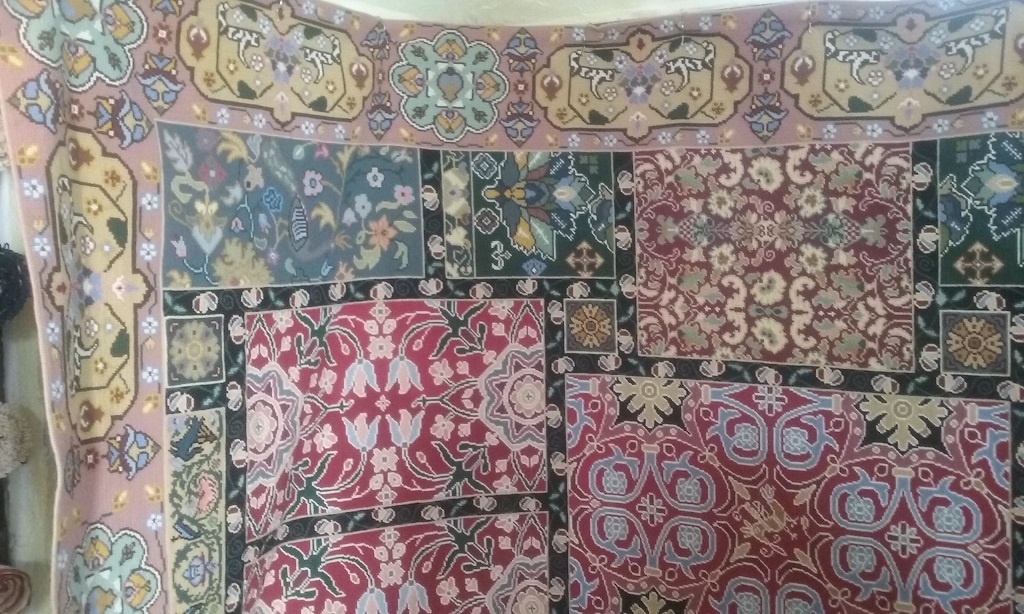
Dan Modeled His Rug to Be on a Portion of This Larger Piece
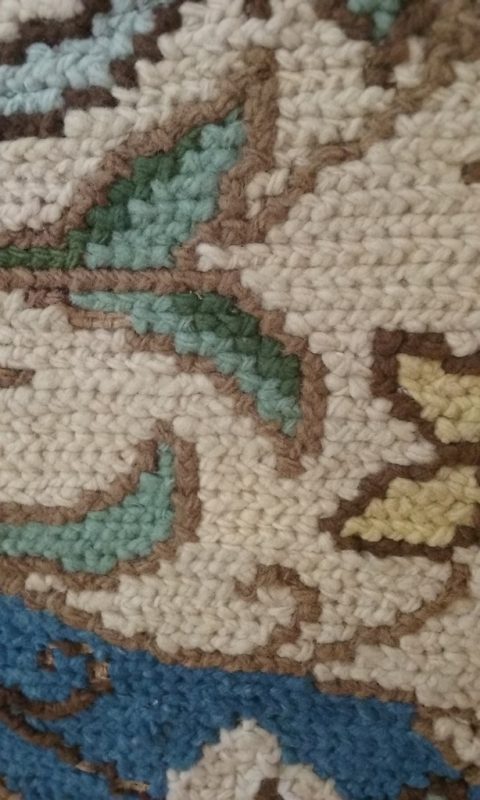
Closeup You Can See the Level of Detail, Countless Cross Stiches Make up a Rug
Dan’s rug is expected to arrive in about a month. And I decided that I would have some pillows made, once I got to check out her patterns online. So it could be a few months before I have them in hand. Mission accomplished!!
From Hortense’s shop we headed straight to Évora and, upon arrival, we once again wound our way up a hill. Although this time, our pousada was on top of the hill, right next to the Roman Temple! The pousada was converted from a convent. The hotel rooms were the cells for the nuns. Although we lucked out and got a “suite”- sweet!
It was constructed in 1487 and used as a convent until 1834. It fell into a state of disrepair until 1965 when it was converted into an elegant pousada and Portugal has declared it a national monument. We looked around a bit, but wanted to get outside walking, perhaps grab a bite to eat, and get the lay of the land before we went full swing tomorrow.
Botequim da Mouraria was a restaurant we saw recommended in three different sources, so it was number one on our list. We walked there and there was a sign saying he is on vacation until November 2nd. Taberna Tipica Quarta Feira was a restaurant that Salt of Portugal blog endorsed. They said Dias cares about knowing where every ingredient comes from- veggies, cheese and even the clay pots used to serve food. We walked there and when we walked in he told us the whole place was booked for a party. We read about Luar de Janeiro in the Lonely Planet which stated the ambiance wasn’t great, but the service was excellent and the chef drove miles to source the best of everything. So we decided to give it a try.
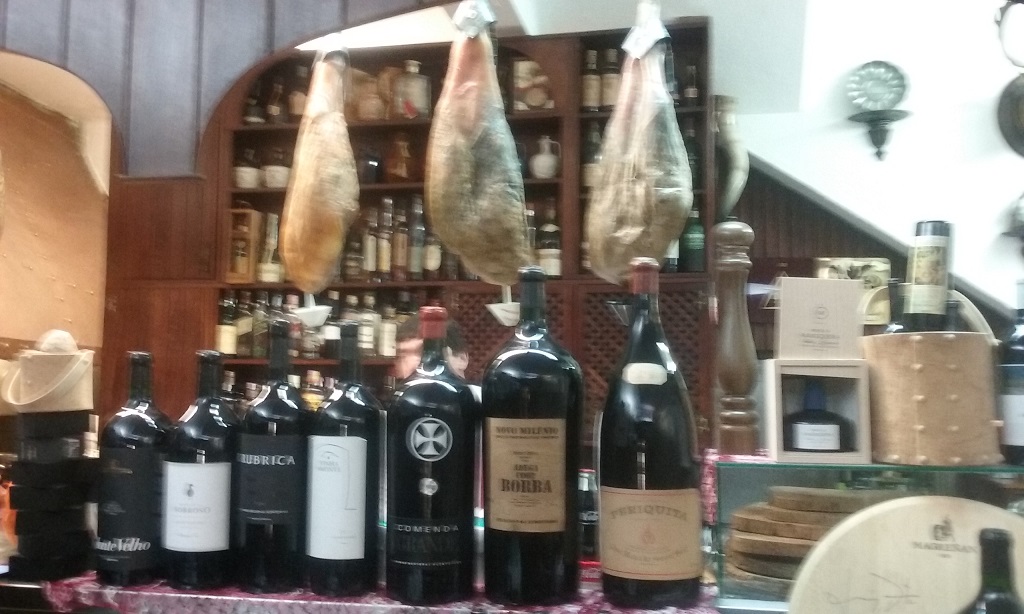
Luar de Janeiro Is Well Stocked with Iberian Ham and Portuguese Wine
It turned out the third time was the charm. When we walked in, we were seated at a table that already had four types of appetizers and bread laid out. In Portugal it’s customary to be given appetizers at the beginning and then get charged for them. They are referred to as couvert. You need to specifically inform them otherwise, if you don’t want them.
At the chef’s recommendation we shared a delectable grilled grouper. By the meals end, we had concluded that the Portuguese use more olive oil than the French use butter.
Following dinner, we had a nice long walk. Even though we didn’t intend to, we went in three big circles. We kept passing the same plaza and feeling like we were experiencing déjà vu. These walled medieval cities are something of a challenge to navigate, as the streets wind a lot and the buildings all look the same, particularly at night with little or no street lighting. In our wanderings, we did stumble upon the Roman aqueduct, which was very cool, and figured we could explore it more tomorrow when we had time on our side. Anyway, our circular déjà vu experience was our version of getting the lay of the land.
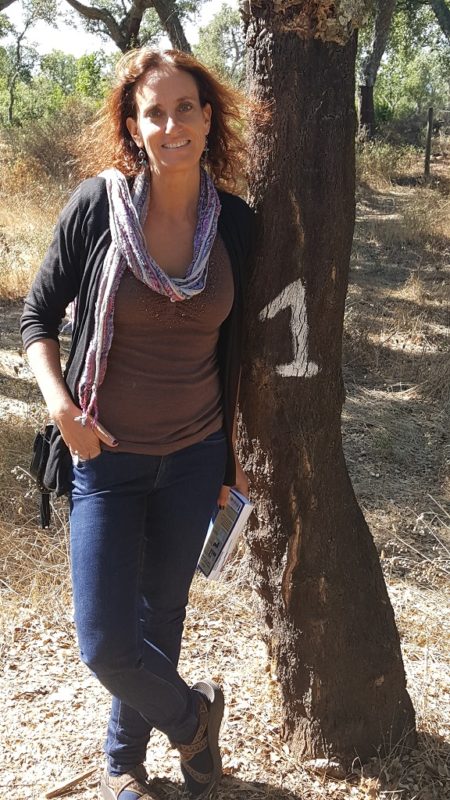
The Number Helps Oak Farmers Keep Track of When the Cork Was Harvested
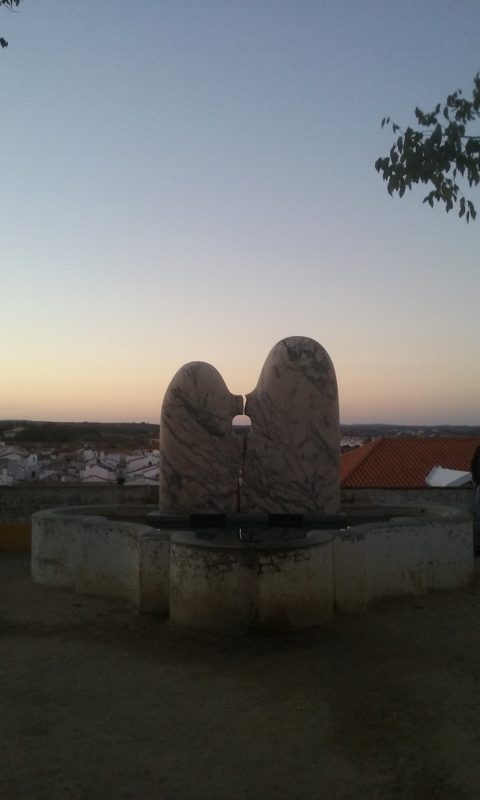
Marble Megaliths At Sunset in Évora
